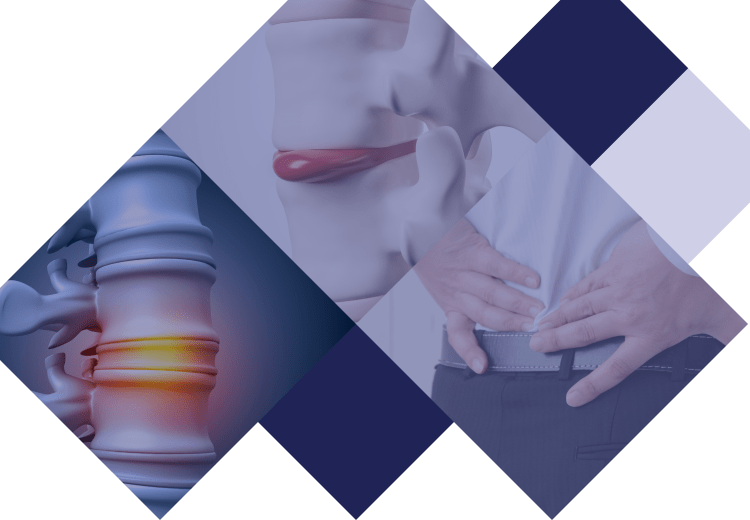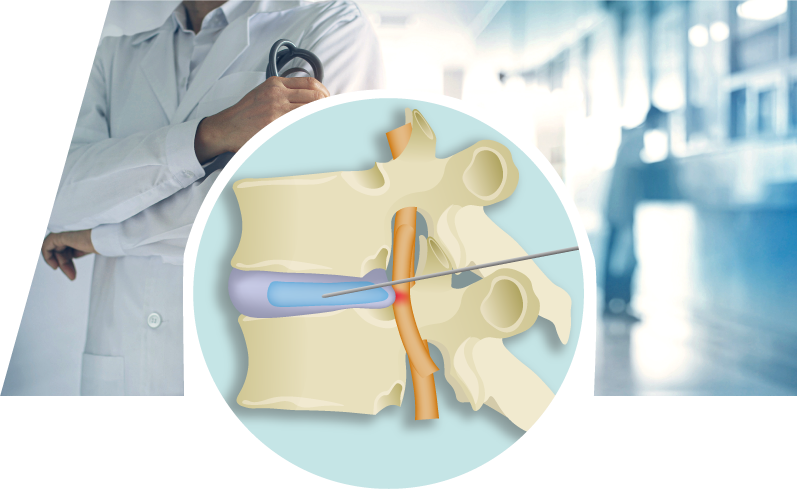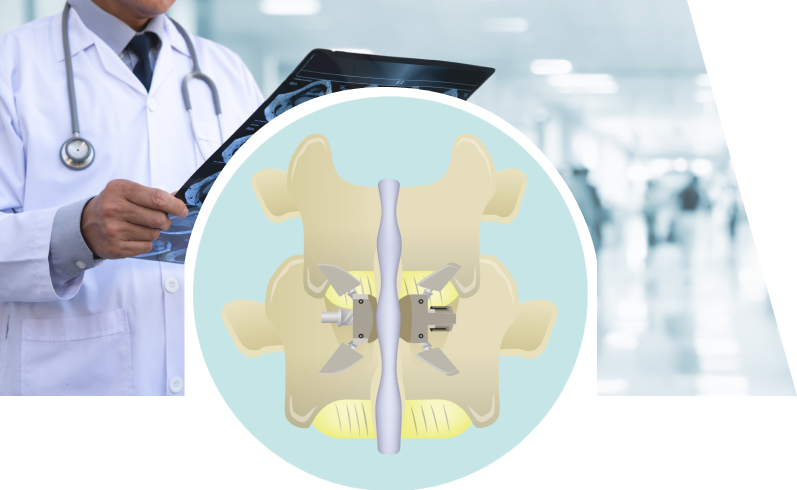Treatment Overview
A method for repairing and restoring intervertebral discs,
the [Cellgel Method] and a state-of-the-art
outpatient treatment for spinal canal stenosis,
the [Florence Method] are now available in Japan!
For those who have been told it was impossible to operate,
For those who have had recurrence of pain post-surgery,
A low-risk, outpatient treatment is now an option for you.

Treatments We Offer
Our clinic provides minimally invasive, same-day treatment for various spinal diseases such as spinal canal stenosis and intervertebral disc herniation. In addition, our clinic only provides treatments that have been proven medically grounded and effective based on years of research, papers, and actual treatment results.
Although it took a lot of effort and time to introduce advanced treatment methods from overseas, we hope that the treatment will satisfy patients from all over Japan and overseas.
There are five treatment methods available at our hospital, but the doctor will take the time to examine you for 30 minutes, explaining the true cause of your pain and understanding why our treatment can alleviate your pain. Based on this careful examination, we will consult with you and select the treatment method that suits you from the five treatment methods listed below.
The World's Most Advanced Lower Back Pain Treatment
The Cellgel Method
The Cellgel Method is a back pain treatment method that has been introduced in more than 54 countries around the world, primarily in Europe.
With this method, the disc volume is not decreased, and the treatment remains in the disc as a gel-like implant, thus restoring and preserving the disc. It's also suitable for a wide range of conditions.
The treament is a one-day procedure, making it more accessible to patients who are busy or living far away.

Florence Method
A revolutionary new outpatient treatment for Spinal Stenosis! Used mainly in Europe and South America, it is now available at our clinic.

-
Hybrid Laser Method
This is a minimally invasive treatment for disc herniation that combines the benefits of both laser therapy (PLDD) and ozone therapy (PODD).
-
PODD Method
(Percutaneous Ozone Disc Decompression)Percutaneous Ozone Disc Decompression (PODD) has been performed mainly in Europe since the 1990s. It can be applied to facet joint disease, disc herniation, spinal canal stenosis, etc.
-
PLDD Method
(Percutaneous Laser Disc Decompression)Percutaneous Laser Disc Decompression (PLDD) has been has been the major outpatient disc laser procedure in Japan since the 1980s. It is the primary treatment of choice for herniated discs.
Treatments to Prevent Recurrence
Rehabilitation for Lower Back Pain
Rehabilitation improves back pain and symptoms caused by joints, muscles, and ligaments. Our personal trainer will provide direct one-on-one instruction using advanced lower back pain treatment equipment.
Cost of Treatment for the Cellgel Method
| Number of Discs Treated |
1 disc | 2 discs | 3 discs | 4 discs | 5 discs |
|---|---|---|---|---|---|
| Lumbar Disc Treatment | 1,320,000 JPY | 1,430,000 JPY | 1,540,000 JPY | 1,650,000 JPY | 1,760,000 JPY |
| Cervical Disc Treatment | 1,760,000 JPY | 2,090,000 JPY | 2,420,000 JPY | 2,750,000 JPY | 3,080,000 JPY |
Cost of Treatment for the Florence Method
| Number of Discs Treated |
1 disc | 2 discs |
|---|---|---|
| Treatment Costs | 1,540,000 JPY | 2,090,000 JPY |
Cost of Treatment for the Hybrid Laser Method
| Number of Discs Treated |
1 disc | 2 discs | 3 discs | 4 discs | 5 discs |
|---|---|---|---|---|---|
| Treatment Costs | 440,000 JPY | 495,000 JPY | 550 000 JPY | 605,000 JPY | 660,000 JPY |
Cost of Treatment for the PODD Method
| Number of Discs Treated |
1 disc | 2 discs | 3 discs | 4 discs | 5 discs |
|---|---|---|---|---|---|
| Lumbar Disc Treatment | 330,000 JPY | 385,000 JPY | 440,000 JPY | 495,000 JPY | 550,000 JPY |
| Cervical Disc Treatment | 770,000 JPY | 990,000 JPY | 1,210,000 JPY | 1,430,000 JPY | 1,650,000 JPY |
Cost of Treatment for the PLDD Method
| Number of Discs Treated |
1 disc | 2 discs | 3 discs | 4 discs | 5 discs |
|---|---|---|---|---|---|
| Treatment Costs | 308,000 JPY | 363,000 JPY | 418,000 JPY | 473,000 JPY | 528 000 JPY |
* The cost of treatment is indicated including taxes.
*If treatment is performed at our clinic, all examination/diagnosis costs and test costs such as MRI are included in the above costs.
*This treatment method is not covered by Japanese health insurance, so you will have to pay for the entire treatment yourself.
*Payment by credit card (VISA, MasterCard, JCB, American Express, Diners, Discover) is also possible.
*If you would like rehabilitation (low back pain specialized rehabilitation), it is also possible to pay by bank transfer.
*If you live and work in Japan, you can receive a tax refund by filing your final medical expense return.
Our Treatment Methods versus Conventional Surgical Procedures
| Our clinic's treatments | Traditional Surgery | ||||||
|---|---|---|---|---|---|---|---|
| Cellgel | Hybrid Laser | PODD | PLDD | Florence |
Micro Endoscopic Discectomy (MED) |
Spinal Stabilization Vertebroplasty |
|
| Disc Restoration | ○ | × | × | × | × | × | × |
| Post-treatment Change in Disc Volume |
Same to increased | Slight to small decrease | Slight decrease | Small decrease | Same | Decreased or disappeared | Decreased or disappeared |
| Supressing of Inflammation |
○ | ○ | ○ | × | × | × | × |
| Duration of Treatment |
15–20 minutes | 20–25 minutes | 10–15 minutes | 10–15 minutes | 30 minutes | 40 minutes – 1 hour | 1–1.5 hours |
| Period of Hospitalization |
N/A (outpatient) |
N/A (outpatient) |
N/A (outpatient) |
N/A (outpatient) |
N/A (outpatient) |
About 1 week | About 1 month |
| Treatable Symptoms & Conditions |
Most lower back related conditions and symptoms | Disc herniation | Most lower back related conditions and symptoms | Disc herniation | Spinal canal stenosis, intervertebral disc hernia, facet joint disease, spondylolisthesis | Disc herniation, spinal tumor etc. | Spinal stenosis, spondylolisthesis, scoliosis, lumbar instability, intervertebral herniation, compression fracture |
Swipe left/righ
About Back Pain
There are many different causes of back pain symptoms, and depending on the cause, back pain may vary slightly from patient to patient. Pain or numbness from the lower back to the calf may indicate a slipped disc, inflammation of the sciatic nerve, or intermittent claudication. When consulting a doctor for back pain, be sure to tell them exactly how your back hurts and other places where you feel discomfort.
At our clinic, we provide an outpatient treatment, which does not involve any scalpels - only needles. Hence, this treatment is less burdensome for the elderly or people that are wary of surgery. We also welcome consultations with patients who are considering conventional surgery.


